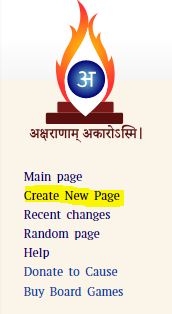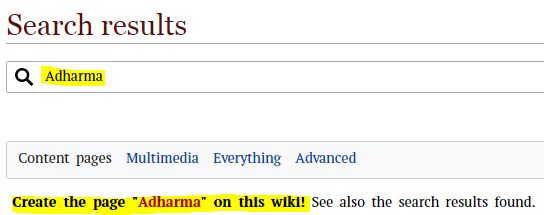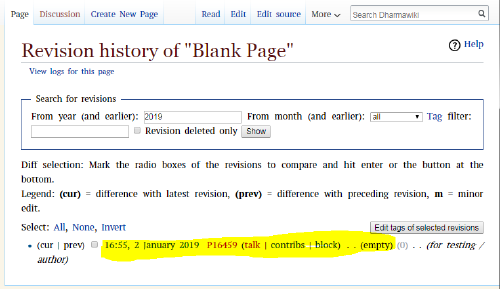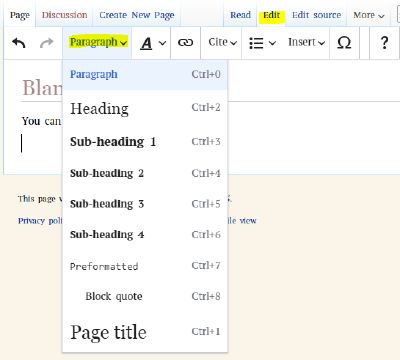Author Help
Dharmawiki article structure has many features that are user friendly both for the Authors as well as the Readers. This page introduces a new Author to different Articles structured in the lines of Wikipedia and have the following features.
- Well inter-linked, or cross-referenced. Highlighted text in blue color is seen in an article, it means there is a link to a relevant article being built with further in-depth information. Holding the mouse over the link will often show to where the link will lead.
- Hierarchy of articles is built through the Category structure. This helps the Authors and Readers to easily navigate through the site and add relevant pages.
- Articles have a page layout which is simple, highly organized and powerful in design. Page aspects include
- Table of contents
- Sections (lead section) and Subsections following the lead section or Introduction
- Reference Links
- Images
- Tables
- Flowcharts
- Formatting tools (such as bullet points and numbered lists)
- Templates (such as To Be Edited) to point an author to the further requirements of the article
- Use of Devanagari characters from the Special Characters list.
- At the end of most articles, there is a relevant References section where the references cited in the article are automatically placed as a built-in feature of the software. Links to external websites and pages, reference material, and organized categories of knowledge which can be searched and traversed in a loose hierarchy for more information are listed. Links within the articles may be given to other repositories such as Shodhganga theses, Dictionaries such as Shabdakalpadruma and Vachaspatyam.
- Creating Articles is elaborated here in the further sections (More information is available in the User's Guide for information on using the wiki software.)
- New authors are required to familiarize themselves with the software guidelines for editing or formatting as follows:
- Knowing how to begin editing
- Adding text
- Making existing text bold
- Making existing text italicized
- Creating a new subsection, with correct subheading level and section content
- Adding a citation
- Editing a citation
- Adding an internal wikilink
- Removing an internal wikilink
- Adding an external link to the External Links section
- Finalizing/saving edits
Create New Page
A brand new author can access the links to Create a New Page only after he/she gets logged in. Authors should familiarize themselves with the following documents before attempting to create content on the site.
- Dos and Donts for a Guest Author
- Dharma Point of View which defines the Content Policies for Dharmawiki
- Guidelines for Authors and Editors defines the content guidelines used on the site and software usage
- Contact a Dharmawiki Editor for any guidance during creating a new page
A new page can be created in one of the following three ways :
- From a Link
- From a New Search
- From a URL
From a link
Once logged in with their credentials, Authors may click on the Create New Page link on the Side bar or on top of the Article next to the Discussion Page to Create a New Page with appropriate title format as defined in the standard Formating Guidelines. Once created the content can be added into the page in a simple way.
Some pages contain red links such as the one seen below. They are typically like place holders and prompts to other pages that don't exist yet (do not have content in them) and are generally required for completing the concepts.
- To create a new page from one of these click on the red link. They are typically created in preparation for leading to creation of a new page from an existing page.
- Check the spelling of the title and whether it is in the required format before creating the page. Make sure that the site does not contain a duplicate entry of the same page and if the content is found under another similar name page.
- If there isn't already a new page link to the page you want to create, you can always add such a link yourself. You would add the new page link typically in a related page, an index page or your own user page.
- Once a page is created from the red link, refresh the original article which led you to this page, the link becomes blue in color indicating that the page now has content.
From a New Search
Another way to create a new page is when you notice a search is not returning any results of valid nature. The search results shows a red linked word which can be potentially created as a new page by following the steps as described above.
- Type the name of the page that doesn't exist in the Search box, and start the search.
- The search results will say that no such page exists. You can create a new page by clicking on the 'red linked' name.
From a URL
The third way to create a new page is by directly typing the required page (eg. Adhikara) in the URL in the address bar of the browser. It is one of the easiest ways to create a new page. You could edit that and press enter. If the typed page does not exist, you can create a new page by clicking on 'create this page' link.
New Page Vs Blank Page
A 'non-existing' or a new page does not have a history, whereas a 'blank' page has a page 'history', although it does not have any content. A non-existing page is created whereas a blank page is created but has no content inside it.
- Creating a new page is just like editing a blank page.
- To create an empty page, save a page with the wikitext __END__. This code will not be saved, it just prevents refusal by the system to create an empty page.
Adding Content in a New Page
After a new page is created, you can add content to it by going to 'Edit' mode or 'Edit Source' mode. You can add content into a new page by just typing it out.
As you can see once you start typing the Save Changes button gets activated from gray to blue.
- 'Edit' mode is preferred to edit text content. 'Edit Source' mode is preferred to edit tables, image indents, hyperlinks etc.
- When you have finished adding your initial text, click on 'Save page'. The new page will be created.
You will need internet connection to save the changes you made for the content to be uploaded and saved in the site. Always check the following before creating a new page
- whether a page of the same or similar title exists
- the content in that similar page is appropriate and relevant
- if the title of the page is according to the format scheme on the site. See Format Guidelines.
Formatting Content in a Page
Once you start adding content in a page by typing it out, you will need simple formatting tools to present your data clearly. An array of formatting tools open up only when you are in the edit mode. The following pictures outline the buttons used to add the various formatting styles supported by Mediawiki.
Bullet Lists
Bullet lists helps the author present data in clear and crisp manner, in short sentences. Bullet lists cannot be indented.
Numbered Lists
Decreasing and increasing the indentation is possible for numbered lists
Paragraph Style
To make headings and subheadings the Paragraph tab has to be accessed. Once the words are in these formats they do not accept the bullet point and numbered lists patterns. For example, Headings cannot be in bullet points.
- Guidelines for Authors and Editors
- Content Formatting Policies
- Technical matters












